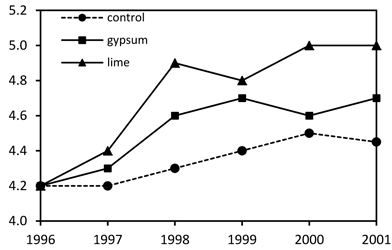Using gypsum in fruit production
When and why to apply gypsum in fruit production is unclear to many growers. Gypsum is beneficial where soils are unusually low in calcium or high in sodium, or where Phytophthora root rot of raspberries is present. Here are the current recommendations.
Gypsum may have some utility in Michigan fruit production, but there is often confusion about when and why it should be applied. It also has not been fully tested on all fruit crops so some information is lacking. Current knowledge and recommendations are reviewed here.
Gypsum (CaSO4.2H2O) contains about 22% calcium and 18% sulfur. Solubility is moderate (2410 mg/L), but much higher than that of lime (15 mg/L). This means that gypsum supplies free Ca++ to the soil solution more quickly than lime.
Soil pH
Unlike lime, gypsum has little if any effect on soil pH. Lime raises pH due to the reaction of carbonate (CO3), not Ca. In extremely acidic soils (pH below 4.5) that contain high aluminum levels, gypsum may increase pH slightly. The chart below illustrates this effect. We applied annual applications of calcitic lime (1,000 lb/acre) or gypsum (500 lb) to a very acidic blueberry soil. Gypsum clearly increased pH, but not nearly as much as lime. If the initial pH of this soil was 6.0 or 7.0, gypsum would likely have had no effect on pH.

Nutrient value
Gypsum contains about 22% calcium and 18% sulfur. If these nutrients are deficient, gypsum can be an economic source. However, Michigan soils nearly always contain adequate calcium if pH is in the proper range. Soil sulfur levels also are generally adequate for Michigan fruit crops. This is partly due to the calcareous nature of much of the parent material contributing to Michigan soils. In fact, several gypsum mines operate in Michigan’s southern (lower) peninsula.
Part of the interest in gypsum is due to the fact that high fruit calcium levels can enhance the quality of various fruits. Unfortunately, increasing soil calcium levels does not generally elevate levels in the fruits, but can reduce magnesium or potassium uptake. Adding more calcium to soils that already contain sufficient amounts can cause deficiencies of magnesium or potassium. Fruit crops benefit from balanced levels of calcium, magnesium and potassium. A healthy balance, expressed as a percentage of soil bases, is 60-70 % calcium, 20-30 % magnesium, and 10 to 20 % potassium. If calcium represents less than 60% of the bases, particularly on sandy soils, gypsum may be helpful.
Soil structure and drainage
In soils with good structure, clay particles are clumped together (flocculated) to produce channels that speed drainage. Ions that carry a double positive charge (divalent cations) such as calcium and magnesium promote flocculation, whereas ions with a single positive charge (sodium, potassium) tend to disperse clay particles and plug drainage channels. If soils are high in sodium, adding calcium as gypsum displaces sodium from soil particles and improves structure. Fortunately, few soils in Michigan are compromised by excessive sodium, so gypsum is unlikely to enhance soil structure and drainage in our area.
Diseases caused by Phytophthora
Gypsum has been shown to reduce disease caused by some species of the fungi Phytophthora. The effect does not appear to be related to improved drainage, but rather to the specific effects of high soluble calcium concentrations on growth of the fungal pathogen. Phytophthora root rot of raspberries is one such case. In sites with a history of root rot, pre-plant applications of 3-5 tons of gypsum are suggested. More research is needed to understand when benefits can be expected and whether other Phytophthora diseases of Michigan fruit crops might also be suppressed by gypsum use.
Gypsum can be a useful soil conditioner and source of calcium and sulfur for crops. Because Michigan soils generally contain sufficient calcium and sulfur for fruit production, gypsum is only expected to be beneficial where soils are unusually low in calcium or high in sodium, or where Phytophthora root rot of raspberries is present.



 Print
Print Email
Email


